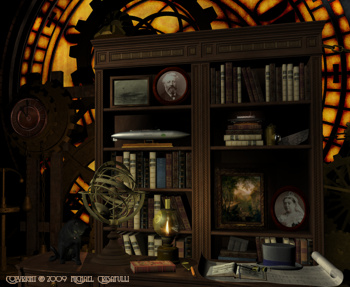|
 started this site in 1997 with only a vague idea of what I wanted to
feature. Karen and I did a lot of traveling, much of it focused around our
volunteer activities with Earthwatch on archaeology projects. We took the projects
seriously, studying up before and after and the project location provided a
focus for more extensive travel for sight seeing and experiencing the culture. That seemed
like an interesting possibility, as did the long hikes we took as part of the
sight seeing. So archaeology and hiking became part of the site. Finally, I'd recently begun studying Jules Verne's classic 20,000
Leagues under the Sea with the aim of making an accurate reconstruction of
the submarine Nautilus and the web site provided a forum for that.
It was a surprise to me that the
original English translations of 20,000
Leagues were seriously deficient so a page on the novel and another on
the Nautilus completed the site.
started this site in 1997 with only a vague idea of what I wanted to
feature. Karen and I did a lot of traveling, much of it focused around our
volunteer activities with Earthwatch on archaeology projects. We took the projects
seriously, studying up before and after and the project location provided a
focus for more extensive travel for sight seeing and experiencing the culture. That seemed
like an interesting possibility, as did the long hikes we took as part of the
sight seeing. So archaeology and hiking became part of the site. Finally, I'd recently begun studying Jules Verne's classic 20,000
Leagues under the Sea with the aim of making an accurate reconstruction of
the submarine Nautilus and the web site provided a forum for that.
It was a surprise to me that the
original English translations of 20,000
Leagues were seriously deficient so a page on the novel and another on
the Nautilus completed the site.
Next I needed to find a unifying theme for these
diverse subjects. The novel and the Nautilus were easily
connected. Archaeology is the uncovering of a record of history and if I
considered a novel or writing in general a kind of history I had a
justifiable connection. Hiking in the natural landscape led me to the
connection with geology and deep time, although more superficial landscape
changes happen in historical time. So time appeared to be a unifying concept.
Reading and evaluating the descriptions in a novel, archaeological excavation,
and contemplating the landscape while hiking all became kinds of time travel and
the site was born.
Over time the relative
importance of parts of the site evolved. My study of Jules Verne and the Nautilus
and communication from others with similar interest led me to the unusual cigar
ships and submarine technology in the nineteenth century. I recreated the
Nautilus in 3-D graphics and that reconstruction concept easily migrated to the
cigar ships. The recovery and subsequent excavation of the Confederate submarine
Hunley had an obvious connection to Nautilus part of the site and
to the archaeology pages. With the Hunley I had the opportunity to
illustrate and comment the archaeology using the experience I'd accumulated in
months of archaeological field activity and to apply the reconstruction techniques I'd
developed for the Nautilus and the cigar ships.
After a decade Gallifrey
had crystallized as the unique source of information on the Internet for the Nautilus,
the cigar ships, and the Hunley reconstruction, while the rest of the site
became something of a pedestrian sidelight. The search engines showed this
for the Nautilus and cigar ships. A proliferation of sites on the Hunley diluted
the search ranking for that section, but my own surveys have consistently shown that my
Hunley pages provide more and better information.
Then Gallifrey regenerated ...
|
 n 2010
personal web pages were
discontinued by AT&T. Forced to restructure the site, I took the
opportunity to reevaluate the theme. Considering the unique appeal
of the three main parts and acting on a recommendation from a colleague, I
decided to emphasize the unified relationship among them - nineteenth century
technology - but expressing it as the Jules Verne connection. The
steam punk genre, which springs from that time and technology, appeals to
me but I wanted to only hint of this. An unrelated comment by
someone who prefers the "Era of Jules Verne" to "steam
punk" led me to the site name. Finally, still liking the less
popular personal pages about archaeology and hiking I found legitimate if
tenuous connections, when one considers the history of the era. n 2010
personal web pages were
discontinued by AT&T. Forced to restructure the site, I took the
opportunity to reevaluate the theme. Considering the unique appeal
of the three main parts and acting on a recommendation from a colleague, I
decided to emphasize the unified relationship among them - nineteenth century
technology - but expressing it as the Jules Verne connection. The
steam punk genre, which springs from that time and technology, appeals to
me but I wanted to only hint of this. An unrelated comment by
someone who prefers the "Era of Jules Verne" to "steam
punk" led me to the site name. Finally, still liking the less
popular personal pages about archaeology and hiking I found legitimate if
tenuous connections, when one considers the history of the era.
Through a misunderstanding/miscalculation on
my part, the original site disappeared only a day or so after the premier
hosting of the new site. Hence I lost the opportunity to link the
two sites and a decade of search engine ranking was gone. Still the
unique content is the same and will get better. I'm sure what was
will be again.
|



